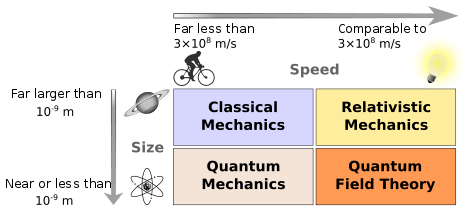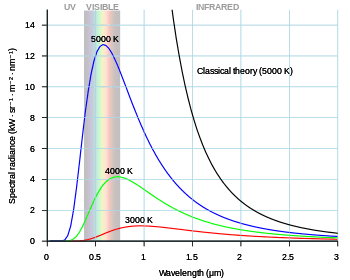Modern physics

Modern physics is the post-Newtonian conception of physics. It implies that classical descriptions of phenomena are lacking, and that an accurate, "modern", description of nature requires theories to incorporate elements of quantum mechanics or Einsteinian relativity, or both. In general, the term is used to refer to any branch of physics either developed in the early 20th century and onwards, or branches greatly influenced by early 20th century physics.
Small velocities and large distances is usually the realm of classical physics. Modern physics, however, often involves extreme conditions: quantum effects typically involve distances comparable to atoms (roughly 10−9 m), while relativistic effects typically involve velocities comparable to the speed of light (roughly 3 108 m/s). In general, quantum and relativistic effects exist across all scales, although these effects can be very small in everyday life.
Overview
In a literal sense, the term modern physics, means up-to-date physics. In this sense, a significant portion of so-called classical physics is modern. However, since roughly 1890, new discoveries have caused significant paradigm shifts: the advent of quantum mechanics (QM) and of Einsteinian relativity (ER). Physics that incorporates elements of either QM or ER (or both) is said to be modern physics. It is in this latter sense that the term is generally used.
Modern physics is often encountered when dealing with extreme conditions. Quantum mechanical effects tend to appear when dealing with "lows" (low temperatures, small distances), while relativistic effects tend to appear when dealing with "highs" (high velocities, large distances), the "middles" being classical behaviour. For example, when analysing the behaviour of a gas at room temperature, most phenomena will involve the (classical) Maxwell–Boltzmann distribution. However near absolute zero, the Maxwell–Boltzmann distribution fails to account for the observed behaviour of the gas, and the (modern) Fermi–Dirac or Bose–Einstein distributions have to be used instead.
.png) German physicist Albert Einstein, founder of the theory of relativity
German physicist Albert Einstein, founder of the theory of relativity German physicist Max Planck, founder of quantum theory
German physicist Max Planck, founder of quantum theory
Very often, it is possible to find – or "retrieve" – the classical behaviour from the modern description by analysing the modern description at low speeds and large distances (by taking a limit, or by making an approximation). When doing so, the result is called the classical limit.

| “ | The term "modern physics," taken literally, means of course, the sum total of knowledge under the head of present-day physics. In this sense, the physics of 1890 is still modern; very few statements made in a good physics text of 1890 would need to be deleted today as untrue... On the other hand... there have been enormous advances in physics, and some of these advances have brought into question, or have directly contradicted, certain theories that had seemed to be strongly supported by the experimental evidence. For example, few, if any physicists in 1890 questioned the wave theory of light. Its triumphs over the old corpuscular theory seemed to be final and complete, particularly after the brilliant experiments of Hertz, in 1887, which demonstrated, beyond doubt, the fundamental soundness of Maxwell's electromagnetic theory of light. And yet... these very experiments of Hertz brought to light a new phenomenon—the photoelectric effect—which played an important part in establishing the quantum theory. The latter theory... is diametrically opposed to the wave theory of light; indeed, the reconciliation of these two theories... was one of the great problems of the first quarter of the twentieth century. |
” |
| — F. K. Richtmyer, E. H. Kennard, T. Lauritsen, Introduction to Modern Physics, 5th edition (1955)[1] | ||
Hallmarks
These are generally considered to be the topics regarded as the "core" of the foundation of modern physics:
- Atomic theory and the evolution of the atomic model in general
- Black-body radiation
- Oil drop experiment
- Franck–Hertz experiment
- Geiger–Marsden experiment (Rutherford's experiment)
- Gravitational lensing
- Michelson–Morley experiment
- Photoelectric effect
- Quantum thermodynamics
- Radioactive phenomena in general
- Perihelion precession of Mercury
- Stern–Gerlach experiment
- Wave–particle duality
- Solid-state physics
See also
References
- ↑ F. K. Richtmyer; E. H. Kennard; T. Lauristen (1955). Introduction to Modern Physics (5th ed.). New York: McGraw-Hill. p. 1. LCCN 55006862.
Further reading
- A. Beiser (2003). Concepts of Modern Physics (6th ed.). McGraw-Hill. ISBN 978-0-07-123460-3.
- P. Tipler, R. Llewellyn (2002). Modern Physics (4th ed.). W. H. Freeman. ISBN 978-0-7167-4345-3.